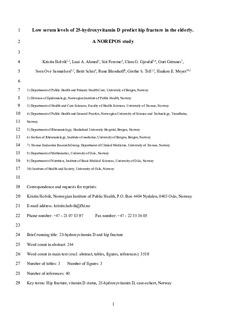| dc.contributor.author | Holvik, Kristin | |
| dc.contributor.author | Ahmed, Luai Awad | |
| dc.contributor.author | Forsmo, Siri | |
| dc.contributor.author | Gjesdal, Clara Gram | |
| dc.contributor.author | Grimnes, Guri | |
| dc.contributor.author | Samuelsen, Sven Ove | |
| dc.contributor.author | Schei, Berit | |
| dc.contributor.author | Blomhoff, Rune | |
| dc.contributor.author | Tell, Grethe S | |
| dc.contributor.author | Meyer, Haakon E | |
| dc.date.accessioned | 2017-12-01T10:07:49Z | |
| dc.date.available | 2017-12-01T10:07:49Z | |
| dc.date.created | 2013-09-13T15:32:14Z | |
| dc.date.issued | 2013 | |
| dc.identifier.citation | Journal of Clinical Endocrinology and Metabolism. 2013, 98 (8), 3341-3350. | nb_NO |
| dc.identifier.issn | 0021-972X | |
| dc.identifier.uri | http://hdl.handle.net/11250/2468720 | |
| dc.description.abstract | Background: Despite considerable interest, the relationship between circulating 25-hydroxyvitamin D and the risk of hip fracture is not fully established. Objective: The objective of the study was to study the association between serum 25-hydroxyvitamin D concentrations [s-25(OH)D] and the risk of hip fracture in Norway, a high-latitude country that has some of the highest hip fracture rates worldwide. Methods: A total of 21 774 men and women aged 65–79 years attended 4 community-based health studies during 1994–2001. Information on subsequent hip fractures was retrieved from electronic hospital discharge registers, with a maximum follow-up of 10.7 years. Using a stratified case-cohort design, s-25(OH)D was determined by HPLC-atmospheric pressure chemical ionization-mass spectrometry in stored serum samples in hip fracture cases (n = 1175; 307 men, 868 women) and in gender-stratified random samples (n = 1438). Cox proportional hazards regression adapted for the case-cohort design was performed. Results: We observed an inverse association between s-25(OH)D and hip fracture; those with s-25(OH)D in the lowest quartile (<42.2 nmol/L) had a 38% [95% confidence interval (CI) 9–74%] increased risk of hip fracture compared with the highest quartile (≥67.9 nmol/L) in a model accounting for age, gender, study center, and body mass index. The association was stronger in men than in women: hazard ratio 1.65 (95% CI 1.04–2.61) vs hazard ratio 1.25 (95% CI 0.95–1.65). Conclusion: In this prospective case-cohort study of hip fractures, the largest ever reported, we found an increased risk of hip fracture in subjects in the lowest compared with the highest quartile of serum 25-hydroxyvitamin D. In accordance with the findings of previous community-based studies, low vitamin D status was a modest risk factor for hip fracture. | nb_NO |
| dc.language.iso | eng | nb_NO |
| dc.publisher | Oxford University Press | nb_NO |
| dc.title | Low Serum Levels of 25-Hydroxyvitamin D Predict Hip Fracture in the Elderly: A NOREPOS Study | nb_NO |
| dc.type | Journal article | nb_NO |
| dc.type | Peer reviewed | nb_NO |
| dc.description.version | acceptedVersion | nb_NO |
| dc.subject.nsi | VDP::Samfunnsmedisin, sosialmedisin: 801 | nb_NO |
| dc.subject.nsi | VDP::Community medicine, social medicine: 801 | nb_NO |
| dc.source.pagenumber | 3341-3350 | nb_NO |
| dc.source.volume | 98 | nb_NO |
| dc.source.journal | Journal of Clinical Endocrinology and Metabolism | nb_NO |
| dc.source.issue | 8 | nb_NO |
| dc.identifier.doi | 10.1210/jc.2013-1468 | |
| dc.identifier.cristin | 1049206 | |
| dc.relation.project | Norges forskningsråd: 191257 | nb_NO |
| dc.description.localcode | Copyright © 2013 by The Endocrine Society. This is a pre-copyedited, author-produced version of the article accepted for publication following peer review. The version of record is available online at: https://doi.org/10.1210/jc.2013-1468 | nb_NO |
| cristin.unitcode | 194,65,20,0 | |
| cristin.unitname | Institutt for samfunnsmedisin og sykepleie | |
| cristin.ispublished | true | |
| cristin.fulltext | postprint | |
| cristin.qualitycode | 2 | |
